Table of Contents
** Minutes
Shopping has always been a social event, and even now with ecommerce we’re seeing a new wave of it unfold thanks to advances in the technology that runs social media and behaviors from Gen Z shoppers and millennial shoppers alike.
For consumers, sharing original content, tagging brands, using their hashtags, and even posting reviews on company pages has never been easier. Many of us even strive to share this level of information in our social lives digitally.
It’s an amazing opportunity for brands, but it can feel incredibly daunting if you’re new to it or don’t have a lot of experience with these social commerce features and options.
To help, we’re giving a deep dive on four of the most popular social commerce techniques along with successful brands that use each tactic. The good news is that you can replicate much of what they’re doing without a huge budget because the nature of social commerce is centered around interacting with your followers and fans.
We’ll remove the concerns around getting started and point you in the right direction, as there is likely much more to social commerce than you even realize.
Of course, people use the term ‘social commerce’ to mean a variety of things, so we’ll start by giving the social commerce definition, jump into examples from brands you can copy or draw inspiration from, and steps companies can take on social media to build their audience and content, and ultimately win new fans.
What is social commerce?
Social commerce is utilizing social media to sell goods or services with optimized content for each channel. It includes a variety of interactions, both in real-time through chatbots and customer service as well as asynchronous communication like posting testimonials, user-generated content, ads, and more to a feed.
In other words, social commerce is how consumers interact and buy on social channels and how brands drive those shoppers to their own website.
4 examples of social commerce
If you’re thinking about social commerce for your brand, it can be helpful to look at it very broadly. This is because some elements that were not always included in past discussions of social commerce — especially ads — are now playing a larger role as technology becomes more complex.
For instance:
- Instagram Shopping posts can now be turned directly into ads after you build out the traditional social commerce aspect of the post.
- YouTube has started offering product storefronts under its shopping ads. While there aren’t yet too many of these ad campaigns live and in the wild, brands that are able to attach themselves to high-quality content related to their industry are going to get a lift just from the social nature of YouTube itself.
Excluding advertising from the overall social commerce space could lead you to miss out on some value that your efforts generate. With that said, let’s walk through the top social commerce techniques and learn what companies with popular social commerce channels can teach us.
1. User-generated content is cross-platform
We’ll begin with a classic: User-generated content (or UGC) is anything that your customers and users on social media create for you. They can create their own fan art, or put together something in response to a specific call-to-action that you create, and you share it with your followers.
UGC is one of the oldest forms of social commerce and selling, and has been around since the time that hashtags began on any social platform. Many companies do UGC well, especially when they pair giveaways with a UGC requirement.
One brand to highlight is Warby Parker. This eyeglasses and frames company has a relatively large following across its social media channels. What’s really impressive is how it leverages a broad variety of social commerce content types and sources.
They utilize UGC from customers sharing photos and videos of everything from their unboxing experience to selfies of them in their new glasses, as well as responses to ad campaigns.
Jump over to the company’s Instagram and you’ll see not only a mix of photos, videos, written items, and drawings, but also content and Tweets screenshotted from when the brand is mentioned or tagged on Twitter as well as other social channels outside of Instagram.


Their content stays culturally relevant and is extremely positive — an established brand attribute. The company is also good at acknowledging content creators and thanking them for what they create and share. They’re a great brand to follow when you want to explore getting creative on the types of UGC you can use.
The takeaway on UGC
UGC is a cheap and effective way to generate content. Encourage followers to become brand advocates by allowing them to share, and then acknowledge and celebrate them when they do. Highlight customers and thank them, while being genuine. Stick to promoting content that matches your brand and you’ll pave the way for satisfied customers, introducing new people to your brand via word of mouth social commerce on a consistent basis.
2. Customer service is a sales tool
Who doesn’t hate listening to terrible hold music on the phone for minutes on end, or sending off a support email in hopes that it doesn’t end up going unseen? Enter, social media.
Today, people can interact with their favorite ecommerce brands at any given moment. When it comes to customer service, they expect those brands to be ready with an answer. That’s a big ask and not everyone is up for the challenge. It’s why practices like conversational commerce have become so popular with SMS ecommerce marketing.
Unfortunately, it’s a demand your customers are going to have, so you’ll need to plan how to address concerns quickly on social channels while also moving them through your system. This might not seem like social commerce as it’s happening after they become a customer, but it can be the make-or-break factor that influences whether someone purchases from you again or participates in other forms of social commerce.
Nike provides us with a good look at how it can be done by offering extremely helpful solutions and being quick to engage and answer questions posed by customers on social channels.
The company’s Twitter support, @teamnike, is one of the better channels out there because they engage quickly and reliably. What sets them apart is that they offer some direct advice and support in conversations, and only move people to direct messages (DMs) when they need more specific information. This social commerce example allows other potential customers to see what Nike is doing to help troubleshoot.
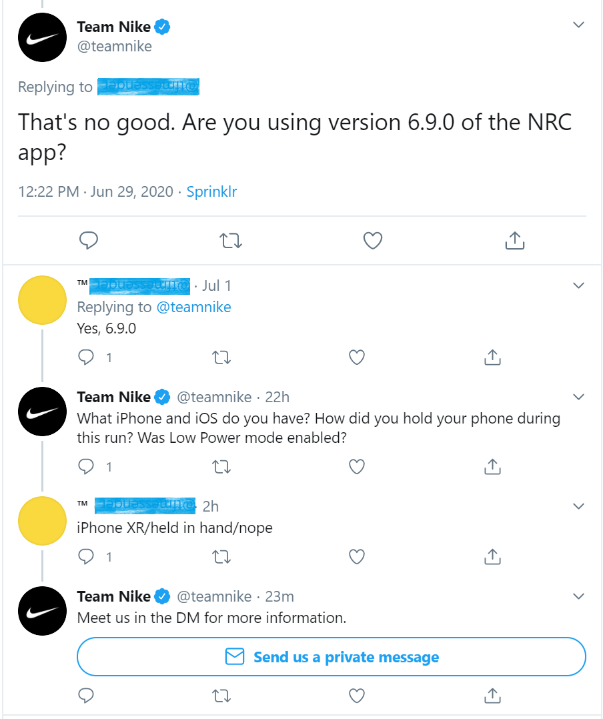

The value in asking questions and engaging first within the social channel is that you can knock out some easy issues or concerns right away before it needs to be escalated to another customer support channel that requires more advanced support.
Other users on social media who are coming to you for help will see that you’re taking time to respond and address issues, and they may even see an answer to their question. It builds confidence that you’re there to help them.
A very public-facing platform that’s actually helpful goes a long way to generating trust in social commerce and will set you apart from the vast number of brands on social media.
The takeaway on social media customer service
Engaging with people in the right ways improves the service that you deliver and can be seen by a larger audience. This yields higher retention rates and can improve your customer lifetime value. Companies with a well-crafted customer service approach can even hit customer retention rates as high as 92%.
3. Testimonials help you convert more shoppers
Testimonials are a useful form of social proof, giving browsers and potential customers an actual customer to hear from when it comes to buying from your business. They are more likely to think that a purchase is worthwhile, making the sales case for you. It’s social commerce at its finest.
Shopify has a great look at the research behind why testimonials work, but the reasoning is simple: Consumers are more inclined to buy when they hear real-world customers talk about their experience with your product. You can tell them how great your solution is yourself, but there’s much more weight held when it’s coming from a human and not a brand trying to make a sale.
Brands can utilize testimonials on their websites or in quick transactional moments through social commerce (e.g., social experiences where there’s a lot more interaction and potential for sharing as well as conversations).
Fabletics has amazing examples of social commerce testimonials because of how well they’re employed across a variety of social channels as well as how easily they turn testimonials into a direct sales tool.
It’s essentially a ‘next-level’ type of UGC, because their customers share how much they enjoy the products and the company utilizes these public comments in its sales funnel. The company even encourages UGC using the hashtag #myfabletics on Instagram and elsewhere.
Fabletics built out a specific page on its website to feature these posts and testimonials from other places. It’s highly visual and when people go there, they’re encouraged to provide additional photos showcasing themselves in the clothing. Customers participate because it’s cool to see themselves featured on a huge brand’s website.
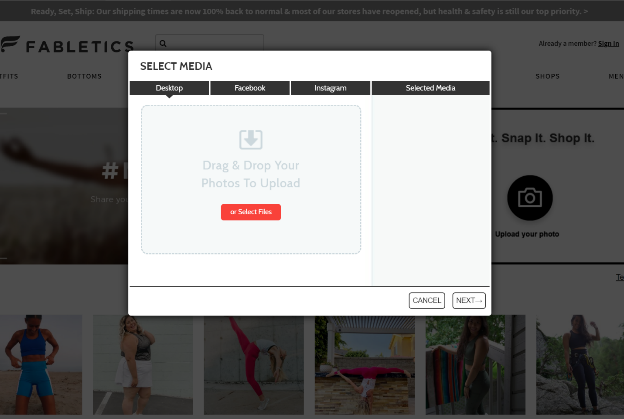

With just a couple clicks, you can add testimonial photos from your phone, computer, Facebook, or Instagram. Then, when you click on the photo in its testimonial mosaic, you get a larger view of the image with the name of the person or group that posted the photo and the ability to buy any Fabletics gear shown in the image. They’ve essentially turned social commerce into direct selling.
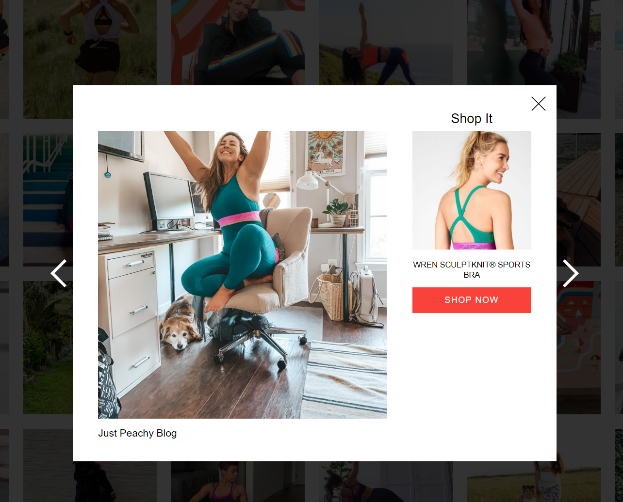

The ‘Shop now’ button takes the user directly to the product page where they can not only purchase the featured product but also see the #MyFabletics photos and ecommerce customer reviews under the standard product description and photo. The entire sales process for some customers will be centered around that hashtag and journey, allowing Fabletics’ existing customers to do all the selling.
The takeaway on testimonials
Testimonials can be just as engaging as any other type of content (and even more convincing), and you can leverage them at every step of your social commerce process. Similar to UGC, loyal brand advocates want to create videos, drawings, photos, and other content around your products. You can choose to accept and leverage it in ways that make sense for social media’s visual and engaging nature.
Be sure to use the appropriate tools for testimonials, such as asking for product reviews via email or asking for Net Promoter Score rankings if you’re in the B2B ecommerce space.
4. Giveaways don’t have to be lavish
Everyone is familiar with a great giveaway, and the gaming space is one of the best at doing it. That’s because they’re in the perfect place to have a large reach and appeal to diehard enthusiasts.
Epic Games commonly offers free games to those interested and spends heavily across social media channels, podcasts, and traditional advertising to spread the social commerce campaign.
These posts get heavy engagement in the form of comments, likes, and shares, and by getting in a lot of gamers’ feeds. This social commerce promotion drives a lot of traffic to the company’s store where you can buy other games, too.
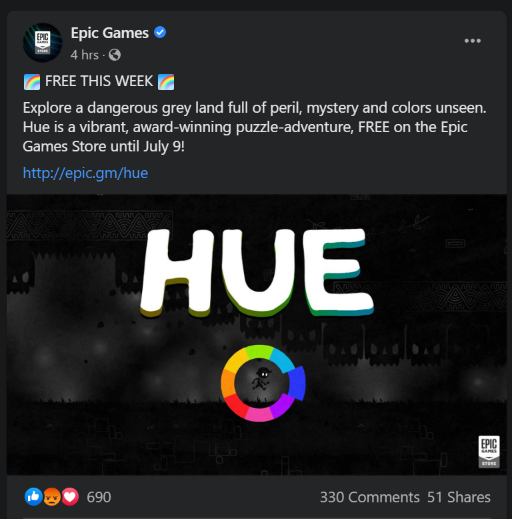

Giveaways can be the great equalizer when you have a product people want. Steam is the most well-known digital gaming service around and has content from the biggest names in the gaming industry. Epic Games’ online store is still very new, but giving away a popular game (GTA V) helped reach 61 million active users and 13 million concurrent users, nearly reaching Steam’s off-peak concurrent user count.
Other publishers go a different route and will give away only a couple downloads of their game but still draw a big crowd. They do this by providing free copies to top gaming content makers, especially people who livestream playing the game on Twitch. These influencers can announce that they’re playing the game and giving away copies, generating prominent levels of engagement for them and significant interest for the game itself.
There are countless iterations of how these giveaways work and how much engagement they generate. The best thing for marketers to do is find something they like personally and try or enter it themselves. This way, you’ll get a good feel for what you think the value of taking the action (e.g., watching a stream, creating an account, sharing a post, or taking another step) is to try to win the product.
Meal replacement brand Ample Foods teams up with tangentially related brands to offer giveaways on Instagram for all of the brands’ audiences to ramp up entries and bulk up the giveaway value.
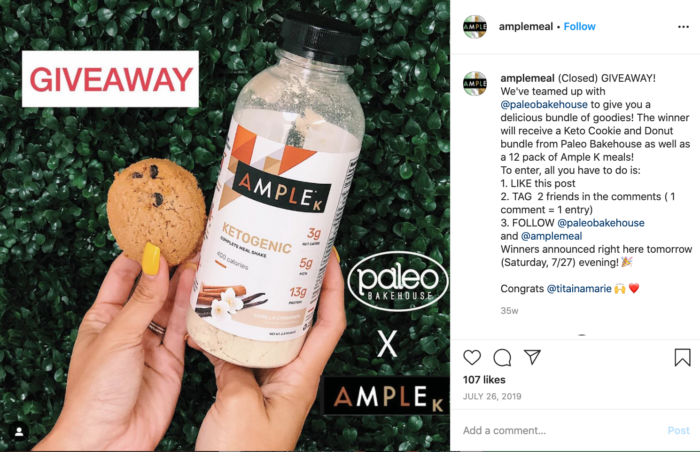

While it might not contribute to new sales immediately, you may get 1,000 new followers and thousands of Instagram comments from a single Instagram giveaway. This social commerce tactic is especially effective if connectedness is important to your brand.
The takeaway on giveaways
By leveraging your fan base and getting them to interact and share with each other for the chance to win free stuff, you can draw in a lot of people. Giveaways can also help build a loyal brand community that reinforces purchases and helps spread the joy of what you offer. Similarly, giving away products to those with a large following can be an inexpensive branding strategy to get influential fans or in front of their audiences.
Finding your social commerce audience
These are just a few ideas to help you get started with social commerce. For the brands above as well as other successful ecommerce companies that are testing social selling, the unifying theme of social commerce is still social. The brands that are doing it best prioritize engagement and make it easy for fans to get involved.
Knock down the barriers and reduce steps for your customers to share about their experience with your products, sign up for more information, leave a review, and more. Simplification is a major part of these marketing efforts. When you keep the process fun and make it rewarding, the people who love your products and brand are going to show up and engage.



